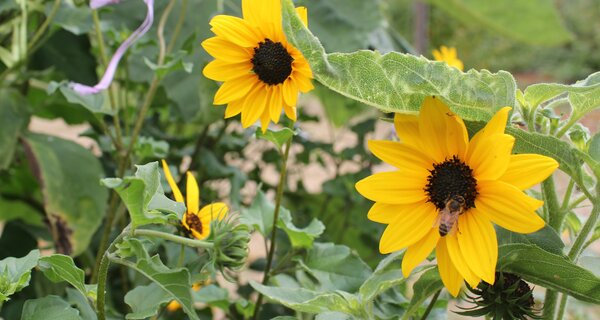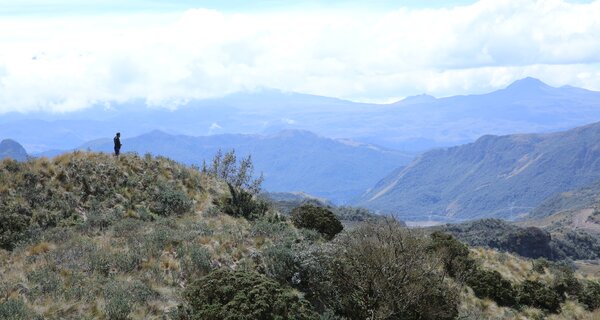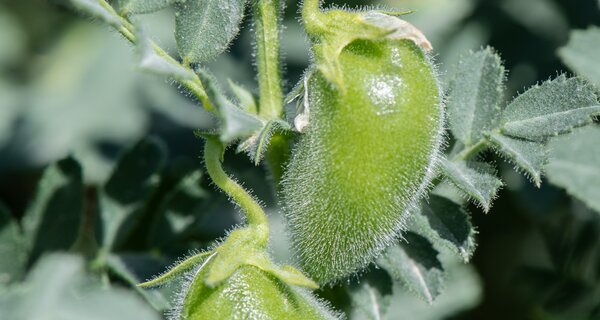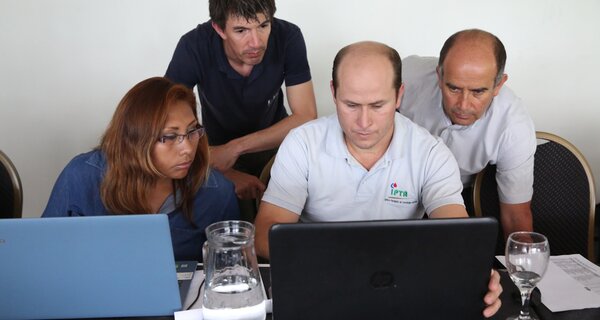Seeking Crop Elders
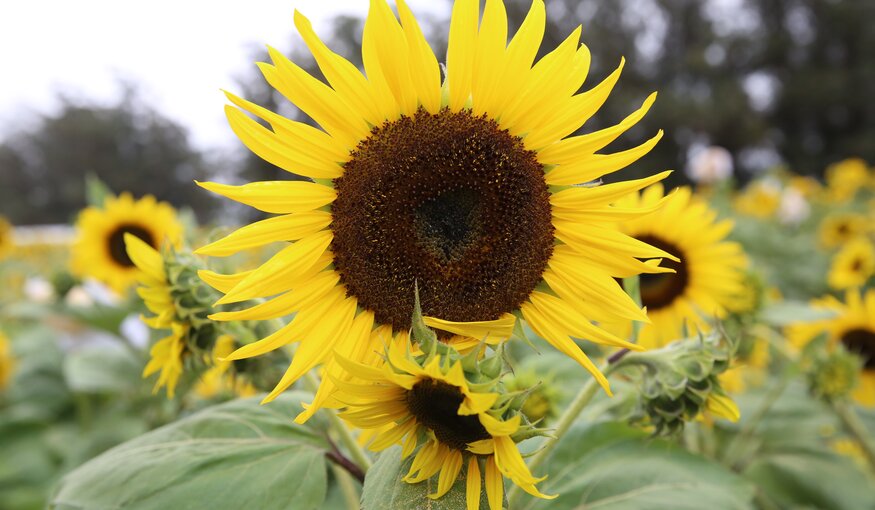
11 December 2015
Scientists and crop breeders are racing to identify the wild ancestors of domesticated plants before a warming world hastens their demise.
David Rupple presses two thumbs into the soft tissues of the sunflower’s broad, droopy face and parts a few of its several hundred mini florets. This flower is most likely an oil producer but he won’t know for sure until he sees the seeds. “Oils are usually all black and a smaller seed,” he says. Hanging chest high from the top of a single fat stalk and laced with a scraggly mane, the flower appears to stare back at him, hot-summer-day bored. Rupple presents two small, black fly-like seeds in his palm. “That’s probably an oil seed there.” He walks over to a much smaller flower a few yards away and plucks two seeds from its face. These large, grey seeds – more clothes moth than black fly – barely seem related to the others
I’m surprised Rupple doesn’t know which is which by sight. Some, like this one, have dinner plate-sized faces, others stand taller and produce smaller, brighter saucers. But Rupple, a fourth generation farmer, is not a sunflower expert. Even with 500 acres of sunflowers planted, that’s less than 10 percent of his 6,500 total acres in Colorado’s Prospect Valley, where he also grows winter wheat, sugar beets, hay, red beans, and corn. More to the point, this is not one of Rupple’s productive acres. We’re standing in a test plot he hosts for Colorado State University Extension, which is running a trial of some 30 recently-bred sunflower varieties for performance in actual farm conditions.
Sunflowers are drought tolerant and easy to grow, but they’re slow to mature and a pain to harvest. Pathogen and pest pressures come into play, too. “We used to just have to deal with seed weevil and now we have head moth also,” Rupple says. To meet his crop buyer’s requirement that less than 2 percent of the harvest have insect damage, Rupple employs aerial pesticide applications. At $26 to $30 per acre that’s a $13,000 input cost. On a good year, one application does the trick.
Of course, sunflowers are not alone in all of this. Each of Rupple’s crops, indeed all domesticated plants grown for food or fiber, face disease and pest challenges of some sort. Agriculturalists are, therefore, forever seeking new solutions. For some farmers, that means embracing chemical herbicides, insecticides, and fungicides. But pesticide resistance grows as surely as pesticide applications do – rendering pesticides ineffective in the long run. Another approach involves the development of new breeds of crops – including genetically engineered varieties – capable of staving off these pressures and allowing a reasonable and profitable yield. But the widespread consumer skepticism of GM technologies makes some farmers reluctant to grow them.
Crops that are naturally resistant to pests and diseases – or resilient to drought and heat – are therefore especially desirable. Yet most crops don’t adapt on their own. They have been rendered evolutionarily inept as a result of the hybridization that domestication demands. In order to develop new crop strains, plant breeders need a wide pool of species and varieties. There’s just one problem: That pool of genetic diversity is drying up.
The sunflower test plot at David Rupple’s farm is a snapshot of agricultural history – a history that is, above all, a story of humans domesticating wild plants. Since the first seed was sown, humans have been selecting for traits favorable to the conditions and desires of the day – drought resistance, pest hardiness, heat or cold tolerance, and, most recently, marketing requirements such as bright color and long shelf life.
But the narrowness of human preferences involves an ecological drawback. Over millennia of farming, agricultural biodiversity has been systematically lost, a narrowing experts call the “domestication bottleneck.” In the last century alone, according to the UN’s Food and Agriculture Organization, there has been a 90 percent reduction in crop varieties. And as humans depend on just a few crops for the bulk of our caloric intake, we become increasingly vulnerable to crop failures – a vulnerability that is intensified by our changing climate and a growing human population.
Restoring the breadth of genetic diversity, then, is critical to twenty-first century agricultural resilience. Plant geneticists and crop breeders are looking to the wild relatives of common crops for adaptive traits that might make today’s crops stronger. The trouble is, these wild relatives don’t, at first glance, seem apt to make our food plumper or tastier – and they’re difficult to work with. Still, bringing these distant wild cousins to the dinner table may be our best hope. What they lack in mannered sophistication, scientists believe, they make up for in rugged survival instinct.
The future health of our global food supply, it turns out, depends on our ability to capture some of this genetic wisdom of the deep past. Troublingly, though, even this is disappearing as these wild relatives are increasingly threatened as their habitats disappear due to human encroachment. Which explains why scientists are racing to identify and preserve crop wild relatives before they are gone.
pass room 243, “Animal Germplasm Cryopreservation Lab,” and then 242, “Tissue Culture Transfer.” Room 233 is “Vegetative Propagation,” and I suspect I’m getting closer to my destination. I’m visiting the National Center for Genetic Resources Preservation in Fort Collins, Colorado, home of the National Seed Bank. Inside are millions of viable seeds representing hundreds of thousands of unique plant types.
My guide is Dr. Stephanie Greene, the seed bank’s curator. The facility is more like a community hospital than the top secret X-Files set I expected given its significance to global food security. Greene shows me germination rooms that look like walk-in refrigerators behind six-inch-thick automatic doors, where, in precisely controlled day- and nighttime temperatures, incoming seeds are germinated for evaluation before long-term storage. Then we get to the main attraction. A swipe of Greene’s security badge and the tapping of a PIN into a numeric keypad release the door. Inside, the vault is nondescript, like sterile library stacks. Large rolling shelf units are sealed with rotating crank handles. Smaller bins above are accessible by ladder.
With its zero degree Fahrenheit clinical chill, I feel as though I’m here to identify the recently dead. “Sterile” and “dead” are ironic associations, however. This room holds one of the most diverse seed collections in the world – a encyclopedic version of David Rupple’s test plot, with approximately 450,000 unique crop strains catalogued here. This is the tree of life itself, the essence of biotic diversity. Viscerally, though, dormancy overrides vibrancy. This is Eden on hold.
Ft. Collins is one of 12 USDA seed banks, and the centerpiece of the nation’s genetic data storage. What’s kept in each specialty regional bank is backed-up here, evaluated, and then shared with international seed banks and other plant breeders. The collection holds modern hybrids, traditional heirlooms, and crop wild relatives – and that’s why I’m here. If the untethered abundance of an heirloom gardener’s riotous plot is part of the effort to reject the domestication bottleneck, these researchers are working to reverse it. In many ways, they are time-traveling to the beginning of agricultural domestication to bring the species of origin – distant ancestors and forgotten wise elders of present-day crops – back into conversation with today’s domesticated descendants.
In sunflower crops, for instance, taking genes from wild relatives has been successful in fighting both downy mildew and fungal rust. Now breeders are looking to wild relatives for resistance traits to combat white mold. “It’s just a matter of getting those genetics into commercial hybrids without compromising the yield,” National Sunflower Association Executive Director John Sandbakken told me before my trip to the seed vault.
Scientists’ awareness of the genetic potential embedded in crops’ wild ancestors is not new. But, Greene tells me, “plant breeders have historically been reluctant to use [wild relatives] because it takes a lot of time and it’s very complicated.” To illustrate this, she compares the process to breeding a wolf trait into a domestic dog to produce, say, a dachshund that can better digest meat or withstand cold. Initial crosses would bear little resemblance to the dachshund, so additional crosses must be made with pure dachshunds until our fictional hound again looks like a dachshund and barks like a dachshund, while also carrying the desired wolf trait.
“Plant breeders are very interested in working with germplasm [seed] that’s within the primary gene pool,” she says. “It all looks good; it’s all, say, a wheat variety.” A secondary gene pool can be used, too, but requires more time to develop into a finished product. Tertiary gene pools require extraordinary effort and patience. “This is a wide cross with a wild relative and you’ve got to excite the embryo because the seed won’t even germinate.” Returning to the dog metaphor, “The third gene pool is that which is super shaggy and takes a lot of work to get to show quality.”
These processes involve “pain-in-the-ass biologies at every step,” says Dr. Chris Richards, a population geneticist at the NCGRP who has worked with crop wild relatives for 15 years. And these specimens are “the hardest to store, they’re the hardest to maintain genetic integrity, and they’re often the hardest to sample” – or collect in the wild. “They’re just the hardest.” But, he says, “The imperative [to collect and breed wild relatives] is enormous given the magnitude to global climate change and population increase.”
Which brings us to what is new for crop wild relatives: the urgency brought on by climate change. The Millennium Seed Bank and Global Crop Diversity Trust have identified that, in addition to increased flooding and drought, “the ranges of many plant pathogens are predicted to shift with the changing climate and, therefore, many areas … may experience disease pressures not previously faced.”
Then there’s the troubling irony that even wild relatives are increasingly threatened in their natural habitats. The Millennium Seed Bank and Global Crop Diversity Trust have identified some 60,000 crop wild relative species. As many as 10,000 could be of “high potential value” to food security. About 1,000 of them are closely related to the most important food crops, but up to 75 percent of those might be threatened in the wild, and climate change is projected to amplify those threats.
The challenge for scientists, then, is to locate the floral “wolves” in their shrinking habitats before it’s too late.
These days, I see sunflowers everywhere I go. Gawky wild things growing along dry highway edges and sprouting on the damp creek banks behind my house. With multiple small heads branching from a single stalk, they are quite different than the single-headed varieties in David Rupple’s fields. Even so, these wild predecessors are a reminder that sunflowers are at home in North America – something that’s not true for most food crops, and certainly not those most important to the US diet or economy.
For Dr. Laura Marek, this is fortunate. As curator of oil seed crops, Marek oversees the USDA’s sunflower collections in Ames, Iowa, as well as her lab’s collection expeditions. To collect wild sunflowers, Marek starts by identifying gaps in the existing collection. Next she turns to old herbarium records, some dating back to the 1940s. For expeditions like a trip to south-eastern Utah last summer, she’ll talk to federal land manager botanists, university taxonomists, and collection record authors. “I talk to whoever’s appropriate,” she says, “so we don’t do too much wandering.” She and her team will do some wandering, though, enough to find sufficient samples, taking note of type, location, soil characteristics, habitat, and topography.
Utah makes for relatively easy collecting. On the East Coast, there is more wild relative diversity, but substantially less remaining wild land. “You go back to some place where there was a nice population 20 years ago and there’s like an interstate interchange or a shopping mall or something,” Marek says.
Most challenging are the international expeditions. “It’s really difficult, currently, to go in the wild in a lot of places because of political instability – certainly in the Fertile Crescent – and other political roadblocks,” Chris Richards says. Collections must be made in the geographic centers of origin, but of the primary species feeding us (six species provide about 85 percent of our caloric intake, Richards says) not one is native to the US. “For instance … trying to get access to areas in southern Mexico is almost impossible,” he says. But for our most widely planted crop, corn, “those regions provide the species range of crop wild relatives that are going to have the most impact.”
Heather Rose Kates is a PhD candidate at the University of Florida working in the phylogenetics of genus cucurbita. Or, in her words, she studies “the evolution of domesticated species of squash to determine how they’re related to each other, when and where they were domesticated, [and] what genetic changes underlie domestication.”
Kates has worked with the USDA to collect drought-tolerant wild squash relatives in the US Southwest. Presently she’s tracking a wild, tree-growing squash, the Okeechobee gourd, which is native to Florida but now endangered. “I’ve gone four times to survey the plant in one of the areas it grows, but I haven’t collected plants yet,” she told me. “Right now air potato” – an invasive wild yam – “is taking over its habitat so it’s hard to see the vines.”
The Okeechobee sends vines into shrubs and trees to bear fruit above ground. It was widespread in Florida until the early twentieth century, when 95 percent of this habitat was converted for agriculture or water-level regulation. “It hasn’t actually become extinct – which is impressive – but it also hasn’t really recovered on its own or spread to any other waterways,” Kates says. Her work is two-fold: to collect for seed preservation, and to spur conservation efforts to protect the natural habitat where Okeechobee currently grows.
“While agricultural land is decreasing, wild land is definitely decreasing,” Kates says. “For a long time we probably thought, This information’s out there, if we ever need [the seeds] we can go collect them. But that’s certainly not true. It really wouldn’t take very much for the Florida squash to be completely gone and any genetic diversity that is within that plant that could’ve improved this particular crop will be gone as well.”
Once a specimen is collected from the wild, the work has only begun. Seeds must be propagated, catalogued, banked, and distributed to other seed vaults. “All of our collections then get backed up at Ft. Collins,” sunflower expert Marek says, “and then, when we have enough seed, they go into Svalbard [Norway] – the so-called ‘Doomsday vault.’”
Marek says her work is preserving genetic diversity for the long term. “In a lot of places stuff is going away,” she says. “They’re building Walmarts and people’s houses and stuff. When we take samples they’ll be there for close-to-forever, probably.”
If climate change pressures and shrinking habitats fuel scientists’ sense of urgency, significant advances in breeding science during the last decade deliver opportunities. Speaking in the soft, measured tone of the researcher he is, the NCGRP’s Chris Richards lays out the historical problems of industrialized farming and the domestication bottleneck, and frames them against future challenges. “By 2050 we need to produce twice as much food, on less land, with less water, for more people,” he says. “It kind of seems impossible,” he nearly whispers as his voice trails off dramatically.
“Well, it only makes sense if you look at our yield-increase curves over the last 60 or 70 years, where we’ve made substantial increases,” he says. Richards credits heterosis – the making of hybrids – for these increases. “Hybrids created this novelty where you combined parts of two different lines and you created this greater-than-the-sum-of-its-parts effect.” Now, he says, creating hybrids not just from another cultivar but from another species may – in addition to increasing adaptability to erratic conditions – increase yields and even nutritional quality.
“We’re reliant on so few species,” he says, “and we’re reliant on the history that those species took from wild to domesticated cultivars. If we were to replay that tape again, we might have slightly different variations because the initial selections may have been different.” With wild relatives, he says, “we have a chance to go back and augment variation to retrieve some of the parts that were left behind during the initial domestication.” These parts may include traits crucial to future crops’ success.
It can be done much swifter than ever before given the new ability to read valuable traits as DNA sequences – to, as Richards puts it, “read their parts lists better.” Genomic techniques allow breeders to identify plants’ fundamental units that are of interest to agriculturalists. “Before, we could only assess what they looked like … but often the phenotypes were so far away from what the breeder was trying to get to, they would sort of despair at the first set of crosses. It would be a really long-term labor of love. Now we can quickly and efficiently identify individuals that are promising and we can advance those individuals forward, leaving the vast majority behind.”
It’s as though our more promising wolf-dachshund crosses could be identified in utero by identifying the desired gene’s presence, rather than utilizing traditional observational methods after the pups have grown. “We can accelerate the breeding programs by an enormous amount using these kinds of technologies,” Richards says, clarifying that this is traditional breeding with advanced observational methods – not genetic engineering.
That same specificity in collecting can then be applied to planting: at first differentiating among broad geographies, and eventually applying nuanced differentiations among micro geographies. “The big growers now realize that actually putting out the same soybean cultivar over a thousand hectares is kind of stupid because of the micro-site variation that exists across that stretch,” Richards explains. “Now, with GPS and these fancy seeders, we can start planting a different cultivar every four square meters,” in what he calls mosaics. “For instance you’re in a drainage and we put a cultivar there that does well lodged underwater. Then you’ve got a hillside that’s a little dry and a southern exposure, put another cultivar there that just sort of does better under those dry conditions.” It’s still all soybean, but now negative variants in yield have been reduced by a fraction. Integrating that across 1,000 hectares, he says, and “you’re making cash money.”
For sunflower, the journey might begin in a wildflower collected in remote Utah. It may be germinated and banked in Iowa and picked up by international breeders identifying the potential for a solution to a vexing sunflower farming problem. During breeding – in with the resistance traits, out with the shagginess – the seed may toggle back and forth from lab to test plot. A few offspring, then, will roll out into broad distribution as a viable crop and will be planted, possibly in subtle mosaics alongside other wild-improved cultivars with complementary micro-variations. The crops might be more resilient, the yields higher, and the pesticide applications lower.
The process, however, will never be complete. While domesticated species do not adapt on their own, the environment around them does. A trait adapted in the wild and bred into the crop, therefore, becomes yet another stagnant characteristic. “With any disease, [the pathogens responsible] constantly adapt,” National Sunflower Association’s John Sandbakken told me. “Nature always adapts. In order to stay ahead of the game we always need to be looking for new sources of resistance.”
It seems an all but impossible task: to collect, catalogue, germinate, and bank the estimated 60,000 crop wild relatives out there. Even tracking the 1,000 crop wild relatives most closely related to critical crops is daunting. I asked Richards if there’s one that got away, an elusive wild trait. “This is a hard question because the driving motivation for collecting representative diversity is the potential of some as-yet-unrealized trait,” he said.
That is: we’re looking not just for the known-unknowns, but also the unknown-unknowns – wildness in its truest form. The imperative is to collect and preserve all the diversity we can while it lasts. In the search for whatever is out there – rather than simply for what’s desired – we might just bring home some elder crop wisdom: a discovery, in the wild, of something we don’t even know we’re looking for.
This article was originally published by the Earth Island Journal and featured on the Crop Wild Relatives (CWR) Project website.
The CWR Project, which ran from 2011 to the end of 2021, was managed by the Crop Trust with the Royal Botanic Gardens, Kew, and implemented in partnership with national and international genebanks and plant breeding programs around the world. This global team of experts collected important species of crop wild relatives, ensured their long-term conservation, and facilitated their use in breeding new, improved crops. The CWR Project was generously supported by the Government of Norway. Launched in 2021, Biodiversity for Opportunities, Livelihoods and Development (BOLD) builds on the work and achievements of the decade-long CWR Project.
Categories: Crop Wild Relatives, Sunflower

